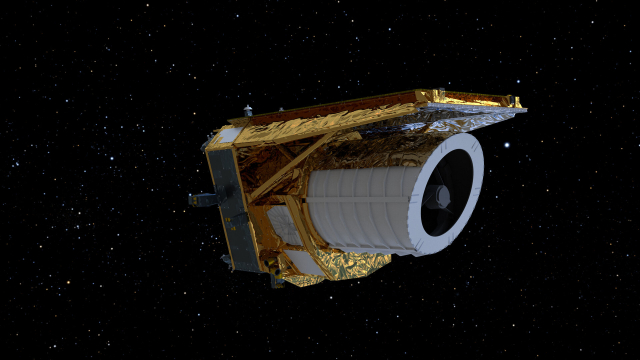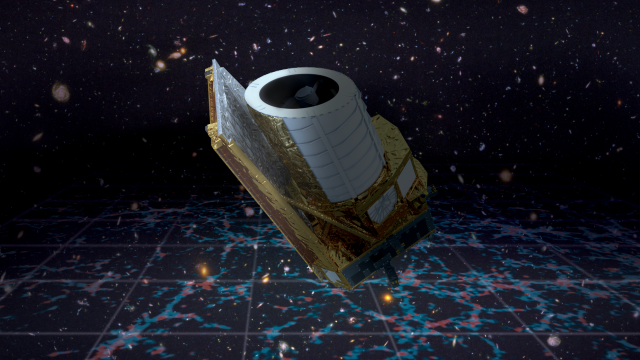Euclid images and videos have been posted.
Note that these are early release images. Full Euclid science operations will start in 2024
esa.int/Science_Exploration/Sp…
esa.int/ESA_Multimedia/Sets/Eu…
#ESAEuclid #Euclid
9/n
Euclid images and videos have been posted.
Note that these are early release images. Full Euclid science operations will start in 2024
esa.int/Science_Exploration/Sp…
esa.int/ESA_Multimedia/Sets/Eu…
#ESAEuclid #Euclid
9/n
This is Euclid’s view of the Perseus cluster of galaxies.
The image shows 1,000 galaxies belonging to the Perseus Cluster, and more than 100,000 additional galaxies further away in the background, each containing up to hundreds of billions of stars, many unseen before.
Observation time: 5 hours
Instruments: VIS and NISP
Size: 8800 x 8800 pixels
The original image has much higher resolution than the image below.
esa.int/Science_Exploration/Sp…
#ESAEuclid #Euclid
10/n
This incredible snapshot from Euclid is a revolution for astronomy. The image shows 1000 galaxies belonging to the Perseus Cluster, and more than 100 000 additional galaxies further away in the background, each containing up to hundreds of billions o…www.esa.int
ESA Euclid webcast will begin at 13:15 UTC (8:15 EDT).
In this video from ESA, scientists describe their reactions to the first images to be released today and explain what these images will reveal about the cosmos.
youtube.com/watch?v=nn1WXAtoDd…
Images will be posted at esa.int/ESA_Multimedia/Sets/Eu…
Event info at esa.int/Science_Exploration/Sp…
Webcast link: youtube.com/watch?v=hHWbe82zM8…
#ESAEuclid #Euclid
7/n

ESA is releasing the first full-colour images of the cosmos captured by its recently launched space telescope Euclid. Follow live a broadcast of the reveal on Tuesday 7 November at 13:15 GMT / 14:15 CET.www.esa.int
The Euclid spacecraft is currently communicating with ESA’s Space Operations Centre in Darmstadt, Germany, via ESA's tracking station at Malargüe in Argentina.
The Malargüe station is ESA's newest tracking station and is located 30 km south of Malargüe, about 1,200 km west of Buenos Aires. DSA 3 hosts a 35m antenna with transmission and reception in X-band and reception in Ka-band.
estracknow.esa.int/#/2023-11;m…
esa.int/Enabling_Support/Opera…
flickr.com/photos/europeanspac…
#ESAEuclid #Euclid #Estrack
6/n
ESA's 35-metre radio antenna in Malargüe, Argentina, has had a major refurbishment. Extenstive modifications made will now allow the ESTRACK network to support future mission like Euclid, launching in 2022, and to transfer data at much higher rates.Flickr
The Euclid space telescope has 2 instruments to analyze light captured by its 1.2 meter 3-mirror Korsch type telescope.
Both instruments have a much wider Field of View compared to JWST and Hubble and have detectors with very large number of pixels.
1. The VISible Imager (VIS) (576 Megapixels) and
2. The Near-Infrared Spectrometer and Photometer (NISP).
The table below shows some key parameters of the instruments.
eoportal.org/satellite-mission…
en.wikipedia.org/wiki/Euclid_(…
#ESAEuclid #Euclid #ESA
5/n
Satellite Mission - Euclid - Mapping the Geometry of the Dark Universe Missionwww.eoportal.org
Launched on July 1, the Euclid space telescope is operating in a Lissajous/halo orbit around the Sun-Earth L2 Lagrange point.
Other space telescopes in orbit around L2 include Gaia and JWST.
Unlike a Halo orbit, a Lissajous orbit precesses after each revolution. Both orbits are unstable and require periodic (~monthly) thruster firings for station-keeping.
This is another raw test image, taken by Euclid’s Near-Infrared Spectrometer and Photometer (NISP) instrument.
NISP has an imager and a spectrometer, which allows it to accurately estimate distances to celestial objects.
esa.int/Science_Exploration/Sp…
#ESAEuclid #Euclid
3/n
Euclid’s two instruments have captured their first test images. The mesmerising results indicate that the space telescope will achieve the scientific goals that it has been designed for – and possibly much more.www.esa.int
We can get a sense of what the Euclid images tomorrow will look like by observing this test image released on July 31. This is a raw engineering image, taken by the VIS instrument, with very little processing; even the traces caused by cosmic rays are visible in this image.
Note that the original image is 24k x 24k pixels!
esa.int/Science_Exploration/Sp…
#ESAEuclid #Euclid
2/n
Euclid’s two instruments have captured their first test images. The mesmerising results indicate that the space telescope will achieve the scientific goals that it has been designed for – and possibly much more.www.esa.int
< 14 hours to go before we see the first full-color images from the ESA Euclid space telescope.
In its quest to study dark matter, Euclid will make a 3D-map of the cosmos by observing billions of galaxies out to 10 billion light-years, across more than a third of the sky.
5 images will be released in a ceremony that will include discussions by mission scientists at ESA’s Space Operations Centre in Darmstadt, Germany.
youtube.com/watch?v=hHWbe82zM8…
esa.int/Science_Exploration/Sp…
#ESAEuclid #Euclid
1/n

ESA’s Director of Science Carole Mundell and leading scientists from across Europe will gather at ESA’s Space Operations Centre in Darmstadt, Germany, to discuss with Media the first, razor-sharp astronomical images of the Euclid mission, looking for…www.esa.int
Here is Euclid's image of the Horsehead Nebula, aka Barnard 33 and part of the constellation Orion, ~1,375 light-years away.
Observation time: 5 hours
Instruments: VIS and NISP
Size: 8800 x 8800 pixels
"Euclid captured this image of the Horsehead in about one hour, which showcases the mission's ability to very quickly image an unprecedented area of the sky in high detail."
The clarity and detail will only get better next year.
We have a new post in our Blog article series illuminating 🪔the #science background 👩🏻🔬 👨🏾🔬 of ##ESAEuclid 🛰️ and the techniques we'll employ for high-precision #cosmology: "Measuring the Universe with Baryon Acoustic Oscillations?"
👉 euclid-ec.org/measuring-the-un…
#astrodon #astronomy #DarkEnergy #DarkMatter #space
A space mission to map the Dark UniverseEuclid Consortium